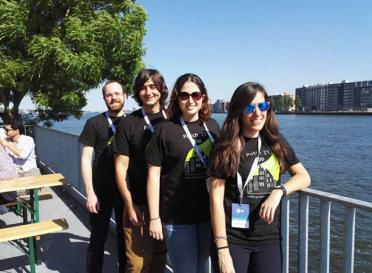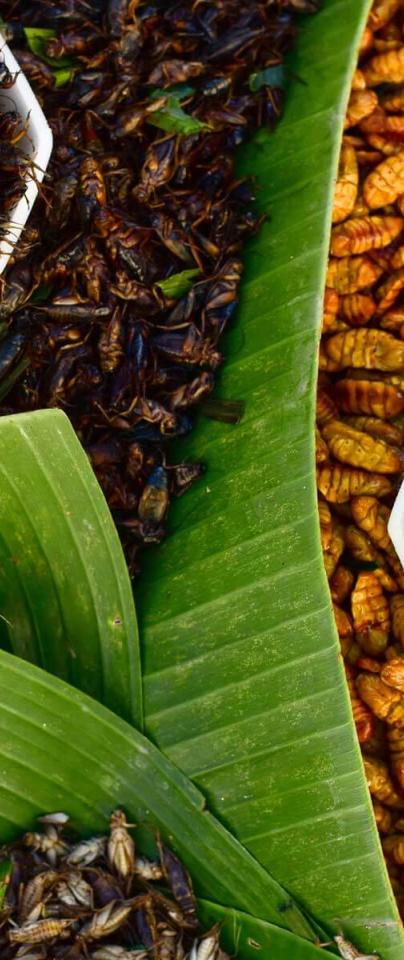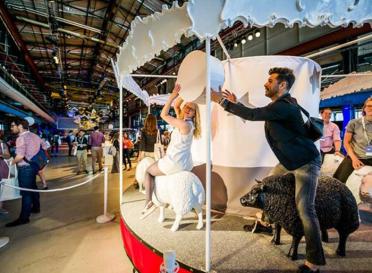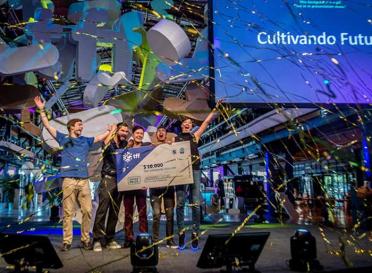Thought for Food: What’s Nexxxt?
Spanning over 130 countries, 1000 universities and 3000 students, this year’s competition was an intense and exciting affair.
Thought for Food has come back bigger than ever this year, boasting an incredible community of passionate thinkers and doers working towards feeding every single person on this planet intelligently and sustainably.
Spanning over 130 countries, 1000 universities and 3000 students, including Benjamen White of Earlham Institute, this year’s competition was an intense and exciting affair, which convened for a fifth TFF Global Summit in the incredible city of Amsterdam over two scorchingly hot summer days.
Nowhere else will you quite manage to find a community such as this.
I feel so lucky to have received an e-mail in 2010, while in the first year of my PhD, suggesting that I take a look at a new competition that the University of Manchester was to be taking part in.
The university wanted to build a cross-disciplinary team, which was to be given the task of coming up with novel solutions to help solve the global food crisis as part of the first ever Thought for Food competition.
As a keen plant scientist, feeding the world has always been at the heart of what drives my passion, therefore I enthusiastically submitted a 200 word paragraph highlighting just what I could bring to the team.
Little did I know how much this paragraph would change my life forever.
The competition has come a long way since those first baby steps in 2011.
In the first edition, we were set a variety of challenges over three months, which saw us taking over the University of Manchester campus, filming videos and writing chalk graffiti to spread the message about food security, and even hosting a pop-up insect eating tent on Oxford Road, called “La Langouste.”
We stayed up late, we played, we dreamed - and we came up with some really amazing ideas.
By the end of the competition, I had cooked insects for hundreds of people, eaten out of bins for three months and even commandeered a group of students to come and find food waste with me in the early hours of the morning, searching through supermarket trash in and around South Manchester.
As a team we had made 48 videos covering an incredible range of topics. We ran around the university campus with bananas and cauliflowers, gorged ourselves on fast food, found out how to make wheat sexy, rescued food waste and handed it out on the streets and we even ripped off a Bob Dylan music video (YouTube didn’t appreciate this as much as our fans did).
This wonderful first edition of Thought for Food featured just ten university teams from around the UK, and I could never have foreseen just how rapidly this competition would transform into such an amazing global movement.
I was asked to take part as a judge in the second installment of Thought for Food, which by this point was already attracting teams from across the world; winners coming from India, Canada and the USA, with whom we brought passion, energy and enthusiasm to the One Young World Summit in Pittsburgh, sharing the same stage as Jamie Oliver, Bill Clinton and Kofi Annan.
A year later, and this time the stakes were raised; $10 000 of prize money going to the winners, Henlight, and $5 000 to the runners up, Agrilution (who I now work for as a plant scientist, four years down the line).

At Thought for Food, you are invited to explore, to wonder, to talk, to play, to engage and to inspire.

I’m a TFF ambassador, I have been since day one. I love Thought for Food. One of my passions in recent years, since I made my first video during the first ever competition, has been to spread the word about TFF, global food security, insect eating and more, through television, radio, newspapers from Mexico to Taiwan, talks at global conferences from Lisbon to Rio de Janeiro, and word of mouth - to basically anyone and everyone within range!
This year, I encouraged two fantastic teams from Norwich to take part in the competition, including Patch IT App, a multitalented team from Norwich Research Park, which included Earlham Institute’s very own Benjamen White, along with Pilar Corredor Moreno, Vanessa Bueno Sancho and Javi Galdón Armero.
The team did so well in the competition that they were invited to Amsterdam as one of the top 20 teams, where Javi delivered a great presentation about their novel application for urban farmers during the pop-up pitch session on the second day.
I asked Ben his thoughts on Patch IT App and what it was like to enter the latest installment of Thought for Food:
Around 20% of the of the world's food is produced in cities, with 800 million people growing vegetables in urban areas. But the lack of support and regulation on urban farming makes this good practice potentially dangerous; with soil contamination being one of the main problems as it can be particularly high in industrialised areas.
To address this we have been working on a user-friendly kit to test urban soils for contaminants, nutrients and pH. The results from this kit are then linked to a smartphone app, PatchItApp, where the users can share information,create local networks, and receive advice on how to treat the soil and what to grow.
Entering is pretty easy and is all done through their site, which comes packed with interactive design labs, coaching, and achievements that can be unlocked to keep your team on the right track.
This helps guide you through the research, talking to the public and prototyping you’ll need to do to ultimately come up with a pitch that’ll be shown to the TFF judges. If your pitch is good enough, you’ll be selected as one of the finalists. Who then go through a bootcamp to get them ready to sell their idea at the Global Summit.
Thinking about solutions that could improve our ability to feed over nine billion people and then working together as a team to develop these into pitches for an actual product.
It gave us a load of useful experiences outside our day to day PhD life and made us think more about what we can do to help solve the global food crisis. In the end, even though we didn’t quite make it to the finals, we were invited to attend the summit and take part in the Pop-Up Pitches to a room full of investors and entrepreneurs.

A Thought for Food Global Summit is like no other conference you have ever attended.
As a scientist, I have been witness to some very tedious events, falling prey to the dreaded “death by powerpoint” on more than one occasion.
TFF is a different kettle of fish entirely.
At Thought for Food, you are invited to explore, to wonder, to talk, to play, to engage and to inspire. With diverse rooms, from pop-up pitches to virtual reality play areas, from having your face drawn in cups of coffee to drinking beer made from potatoes and rainwater, you are never bored.
On stage, keynote talks are delivered by diverse speakers, from heads of corporations to young entrepreneurs.
In and around the summit, seasoned corporate employees mix with young startups and students, who are all encouraged and enabled to foster relationships that would never have been possible anywhere else.
The first thing that you noticed as you came into the venue this year, the industrial Kromhouthal in Amsterdam, was a merry-go-round of white sheep, interrupted by a sole black sheep, as if to encourage one to stick out from the crowd, while to the left was a chill-out room with digital artwork projected onto the walls and swings to help cool down from the summer sun, or to reflect on the day’s multitude of talks, workshops and conversations.
In the middle of the room, highlighting the centre stage from which the conference was hosted by the magnificent Holley Murchison, there was a magnificent cardboard sculpture depicting a Thought for Food tornado, made, as has become routine for the TFF Global Summit, by the incredibly talented team of Portugal’s Oupas! Design.
In this eclectically designed venue, we were asked to broaden our minds in order to explore “what’s next?”
Indeed, this was a novel summit for me, as, in addition to being a speaker and ambassador, I was asked to be a Harvester. In the spirit of the TFF Summit, I volunteered to “harvest” the “What’s Nexxxt” stage, where I would probe the speakers and the audience about what made them curious, how they foster a beginner’s mindset and entrepreneurial spirit, and how combining thoughts and ideas could help us drive forward all aspects of innovation, based on founder Christine Gould’s “6 essential attitudes to next generation innovation.”
In just four hours on a Friday afternoon, our speakers covered a staggering range of topics, including robot farms in Japan, vertical farming in Sweden, in vitro meat, genome editing for design, creative science, bringing virtual reality into education, gamifying sustainability and even fossil fuel-free fertilisers.
From cheese made from toe fungus through to exploring the joys of being a virtual eggplant, we left no base untouched.
I didn’t stop there. In the intervals and breaks, I spent my time wandering between groups of people, asking them what made them curious, and connecting individuals who might otherwise never have started talking to each other.
However, as much fun as this was, it meant that I didn’t get the chance to explore everything I would have wanted to at the summit this year.


Some of the participants from last year (Biteback) were there with their insect oil, a more environmentally friendly and nutritious alternative to palm oil..

Ben White, however, being the curious and devoted student he is, managed to visit almost everything: so how did it go and what were his favourite highlights?
It felt more like some fancy London arts venue than your typical coffee-stained-floor conference. Certainly a place to spur creativity and innovation. The coffee was superb, by the way, but not nearly as good as the morning rave for getting the creative juices flowing.
There was so much room and emphasis on openly networking with people here it’s hard to really give highlights. But there were two really memorable people who I spoke to.
One was Lucas Rizzotto, an award winning designer and coder who is working to use virtual reality and augmented reality to gamify some of the challenges facing global food production. He gave an honorable mention to a certain egg plant game (“I wanna be an eggplant!”) that challenges our beliefs on sexual objectivation.
I also spoke with Mirka Scharf from Crimson Gold, who plans to use the 140,000 million tonnes of tomato skins and seeds wasted every year in sauce and puree production, to make a tomato oil that can be used in place of regular olive or vegetable oil. After tasting some of the tomato oil they had with them, I wouldn’t think twice about using it on my salad.
In fact, they weren't the only delegates with alternative oils. Some of the participants from last year (Biteback) were there with their insect oil, a more environmentally friendly and nutritious alternative to palm oil.
I particularly enjoyed some of the more out there talks, like Koert van Mensvoort’s talk on Bistro In Vitro; a virtual restaurant that challenges our concept of what food is, and how advances in technology and changes to the environment will impact what we know as food in the future.
The great work by Alpha Sennon, self-proclaimed creator of the world’s first agricultural superhero, Agriman, also deserves a mention. Alpha is founder of the WhyFarm non-profit organization that aims to educate children in Trinidad and Tobago about agriculture and what they can do to help the world food crisis. I’m sure we will soon see Alpha and Agriman’s message being spread throughout the rest of the world soon.
It was also great to hear from Ellen de Brabander (SVP R&D Nutrition at PepsiCo), on the challenges of global food production and the work being done to transform the industry to tackle these.
I of course finally need to give a mention to the inspirational founder & CEO of TFF, Christine Gould, and her six essential attitudes for next generation innovation.
Vegan hipster chic with millennial flair.
The content of the Next-Gen Assemblies was varied and far exceeded the reach of just food. Whether it was hearing about advances in lab grown meat in the What’s Nexxxt talks, discussing fake news with other delegates and heads of PR for large multinational corporation in the Honesty Circles, learning about vertical farming as part of a live PodCast or making DIY microscopes and DNA cocktails in the Maker Labs, there was a lot to take in and get you thinking about what you can do to improve all of our futures.
Outside of these sessions there was so much going on, too. I rode a sheep carousel, experienced my first food meditation with a chocolate truffle, had my face expertly drawn on a latte, experienced life as a bird, and ate nutritious powder made from the tons of wonky vegetables discarded every day. I also now know the full theme song to Captain Planet.

To highlight just how global the competition has become, this year’s competition saw students from 132 different countries competing for the grand prize, representing well over half of all the countries on Earth.
As, each year, the competition evolves, this year also highlighted Thought For Food’s commitment to openness, something that Christine Gould, founder and CEO, emphasised in her passionate keynote talk on day one, accentuated this year, as the pitching workshops which the finalists attended in order to prepare their final presentations on stage were open-sourced for the entire Thought for Food community and beyond.
This year’s Thought for Food competition featured four prizes for the ten finalist teams; the TFF Challenge winners and runners-up, the Kirchner Food Fellowship prize, and the “take it to the farmer” prize given by Julie Borlaug of the Norman Borlaug Foundation, which gives special credence to projects that can have an immediate impact on smallholder farmers, and there’s rarely a dry eye in the house when Julie delivers her passionate reasons for why certain teams should get this special prize.
This year, the deserving winners of the “take it to the farmer” prize were Indian team From Challenge to Opportunity, whose multifaceted project tackled multifaceted problems. Using seaweed produced in South India, the team are producing sustainable fertilisers for Indian farmers, while using the waste to make cookies that can be distributed to malnourished children.
The overall winners of the competition were Cultivando Futuro, a team from Colombia whose project was close to some of what we do at Earlham Institute; harnessing big data to provide a “platform that provides key info about: production, commerce, offer and demand, matching the key actors in the chain.”
However, another beautiful Thought for Food moment was born when, after Agrosphere - a team that produces an ingenious enzyme which can degrade harmful pesticides - had won not only the Kirchner prize but also came second in the overall competition, decided to split their prize money between two other teams.
Thus, team Sparky from Uganda, who produce a thermo-dehydrator powered by biowaste to prolong shelf life of food in Uganda, as well as Climate Edge, a UK-based team that provides low cost weather and climate monitoring for smallholder farmers in tropical regions, walked away with money that could have an immediate impact on their important projects.

As much as Thought for Food is an international movement, it is also an ever expanding but ever more tightly-knit family, which was emphasised by the final two performances on stage, both of which were delivered by returning ambassadors of TFF.
Before the finalists were announced, I was fortunate enough to be asked to perform another slam poem for the Thought for Food audience, which I dedicated to biodiversity, togetherness and embracing scientific thought and reasoning, before paying tribute to the wonderful successes of Thought for Food.
It’s amazing how things come full circle. Before Thought for Food, I had never written a poem, and in fact wrote my first ever poem in tribute to Thought for Food. I have since written over 200 poems and performed several of them around the world in front of international audiences from Rio de Janeiro to Lisbon, Zurich and Amsterdam (twice!)
Thought for Food isn’t just about ensuring a food secure world. It’s about inspiring you to break the mold, try something new and broaden your horizons. Try something a little different and see where it might take you, and who you might meet along the way.
For me, the possibilities have been endless, a sentiment shared by our final keynote speaker, Alpha Sennon.
Though I was anticipating something special, I was not prepared for just how incredible this keynote talk would be.
Alpha Sennon, a TFF ambassador who I first met in Berlin three years ago, stole the show with an impassioned and heartwarming account of how he, from hating the whole idea of being on a farm as a youth, is now instilling the passion in young people to love and appreciate farming via his not-for-profit, WhyFarm.
Alpha explained how, from his home in Trinidad and Tobago, he has managed to bring home the importance of agriculture to children around the world, based on his unique and inspirational superhero, Agriman.
He also inspired us to put the I in Idea. That every one of us has the idea that might change the world. He encouraged us to be 1 in 7.3 billion, not just 1 in a million.